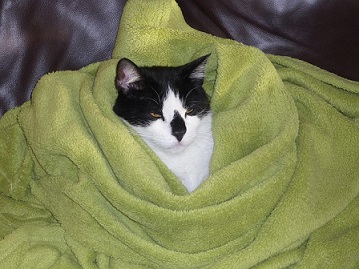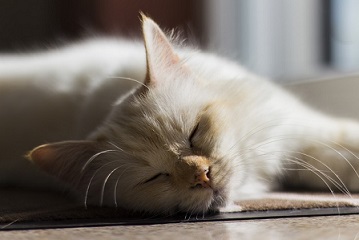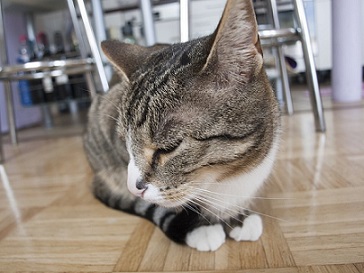
When I leave my cat at home or watch her sleep in the living room at night, I often wonder: What’s the ideal temperature for her? What feels too hot for me might be perfect for her, and vice versa. To better understand my cat’s comfort, I decided to do some research on the topic.
In general, cats can tolerate warmer temperatures than humans due to their body temperature, which typically ranges between 100.5 and 102.5 degrees Fahrenheit ( source: fveap.org). However, some factors influence how well a cat adapts to different temperatures. For example, long-haired cats tolerate cooler climates better than short-haired breeds. A cat’s comfort depends on breed, age, size, and health, so it’s important to consider these factors for their comfort when you’re away or asleep.
Factors That Affect a Cat’s Temperature Tolerance
1. Breed
Long-haired cats are generally more suited to colder temperatures than short-haired breeds. For instance, the Siberian cat, with its thick coat, is naturally adapted to cold environments, unlike the Burmese cat, which thrives in warmer conditions. Breeds like the Maine Coon, Norwegian Forest Cat, and Siberian also have hair-covered paws designed for walking on snow and in cold forests, giving them an edge in chilly temperatures. If you own one of these long-haired breeds, they may feel uncomfortable in high temperatures, while short-haired cats are more heat-tolerant.

2. Age
Kittens need warmer temperatures than adult cats. Due to their smaller size and inability to retain heat as efficiently, a kitten could suffer from hypothermia in normal room temperatures. Older cats may also require warmer environments, particularly if they suffer from joint or bone pain. Keeping them in a warm spot helps alleviate some of that discomfort.
3. Size
Slimmer or small sized cats with less body fat struggle more to maintain body heat. If you have a slim, small cat, you’ll need to provide extra warmth, especially in cooler weather. In contrast, larger or overweight cats are better able to tolerate lower temperatures and may be more comfortable in cooler conditions.
4. Health
Cats with thyroid issues or other health conditions may be more sensitive to cold temperatures, due to the cat’s metabolism change (source: Veterinary Specialty Center Tucson). Cats suffering from health issues or infections typically need a warmer environment to help with recovery. Providing a heated pet bed or blanket can help your pet stay comfortable when they’re not feeling well.

Finding the Right Temperature for Your Cat
While ideal temperatures for cats generally range from 86 to 97 degrees Fahrenheit (a neutral zone for their body temperature), it’s not practical or cost-effective to maintain these extremes at home, especially in winter. Cats are adept at adjusting their body temperature to match their surroundings, but we need to make sure they have the right conditions to do so.
Winter Temperature Recommendations
For healthy, long-haired cats or large cats with a thick coat, you generally don’t need to worry about them getting too cold indoors. Keeping the temperature between 60 and 68 degrees Fahrenheit is usually sufficient. If your cat tends to curl up or seek extra warmth, you may want to adjust the temperature closer to 70 degrees. However, even long-haired cats can feel the chill, so observe their behavior for signs that they need more warmth.
For smaller, short-haired, or skinny cats, you should ensure they have access to warmth during the winter months. You can maintain a room temperature of around 78 to 80 degrees or provide supplemental warmth, such as a heated pet bed. Kittens, in particular, need warmth, so ensure the room temperature is on the higher end of the spectrum and consider additional heat sources.

Summer Temperature Recommendations
In the summer, your cat may prefer a cooler environment. For long-haired, large, or overweight cats, aim to keep the temperature around 80°F or lower. If air conditioning isn’t available, you can invest in cooling pet beds or mats to help your cat stay comfortable.
For slim, short-haired cats, a slightly warmer environment (between 85°F to 90°F) is usually tolerable. Just be sure there’s plenty of air circulation—either by opening a window or using a fan. Kittens, in particular, can handle warmer temperatures better than adult cats, so a temperature in the low 90s might be acceptable for them, as long as they have access to cool resting spots.
💡 Tip: Brush your cat regularly in summer to help keep them cool by reducing excess fur.
Analyzing Your Home’s Temperature and Environment
Cats are natural temperature regulators and have ways of seeking warmth or coolness throughout your home. To help your cat adjust to changes in temperature, ensure that your home provides the following:
Warm Spots for Winter: Cats instinctively seek higher places where warmth rises and sunlight hits. If your home has tall furniture or high shelves, ensure your cat has access to these areas, as they often prefer sitting in sunny spots to stay warm. If your cat doesn’t have access to a sunny window, consider getting a window perch. These are simple to install and provide your cat with a comfortable spot to soak up the sun’s warmth. Cats are highly sensitive to sunlight. While no scientific studies confirm it, a PetMed report estimates that about 30 million U.S. pets show behavioral changes in winter, resembling symptoms of SAD. While not necessarily cat depression, these changes affect their mood and energy levels.

Cool Spots for Summer: In the summer, ensure that your cat has access to cooler areas of your home. Cats naturally seek out tiled floors or areas with better airflow to cool off. If you have a fully tiled floor, make sure there are enough comfortable areas for your cat to relax. A cooling mat or pet bed can be helpful, particularly for short-haired cats or kittens.
Additionally, consider the layout of your home. If your house tends to trap heat or cold in certain areas, this could affect how your cat experiences the temperature. Think like a cat: Does your home have a good balance of heat and coolness, and does your cat have plenty of options for finding a comfortable place to rest?

Takeaways: Key Insights for Your Cat’s Ideal Temperature
To help your cat stay comfortable, it’s important to remember that the ideal temperature range can vary depending on their breed, size, and health:
✅ Neutral Body Temperature: Cats naturally regulate their body temperature within the range of 86-97°F. While this is a theoretical guideline, maintaining these temperatures at home 24/7 is unrealistic.
✅ Winter Recommendations: For healthy, long-haired or larger cats, keeping the temperature between 60-68°F works well. If you notice them curling up more, they may prefer a slightly warmer environment. For small or short-haired cats, 78-80°F is best to ensure they stay warm during colder months, with a heated pet bed as a good option.
✅ Summer Adjustments: For long-haired or overweight cats, keep the home temperature below 80°F to prevent overheating, and consider providing cooling mats. Small or short-haired cats will likely do well in temperatures between 85-90°F, especially when the home is well-ventilated.
Conclusion
To summarize, the ideal temperature for your cat depends on their breed, size, age, and health condition. By setting a suitable temperature range for your home and providing your cat with access to warm or cool areas as needed, you can ensure they remain comfortable, whether you’re around or away. Don’t forget to observe your cat’s behavior—if they seem to seek out extra warmth or chill in a certain area, it may be time to adjust the environment to better suit their needs.
Thank you.
Finally, an article that answers the question, “What temperatures do cats prefer?” and not an end around that turns into “What temperatures can they tolerate?”.
Best regards
You’re welcome Rich!
I have an indoor/outdoor Norwegian Forest type cat about 11 lbs. It is 101f in the shade in my garden today and puss adamantly refuses to come inside where it is a cool 78. I’ve picked her up and brought her in twice but she makes such desperate attempts to get us to let her out we give up.
Hello Jean, it seems like your cat is so happy being outdoor that he doesn’t care about the temperature :)
THANK YOU! THANK YOU!!!
I can FINALLY sleep better from reading an article that finally makes sense.
Sincerely,
Julie (and kitten)
You are very welcome, Julie!
I have concerns it is safe for the cat to be locked in a home with no windows open with temp of 28-30c
I assume you are mentioning Celsius. If the temperature is hot, it’s recommended having a source of air circulating in the room. Hope that helps!
We live on the Texas coast.HOT,HOT,HOT in the summer. Always provide cats in and out with lots of cool water.My two “shop” cats have a pet door to come and go in and out all day.At night in my husband’s shop,where they sleep,I try to keep it at 77-80/Have an ac+a big fan (never aim on cat) and a smaller oscillating one going(also aimed “upward “toward ceiling to help air circulate.(I also add about a tsp of water to their wet food.That helps keep them hydrated.
Hello J. Hoover thanks for sharing your experience. I am sure it’ll help other people whose cats suffer with hot weather as well.
So I adopted a cat and I’m fairly certain he’s a Nebelung. He’s two years old and he’s a healthy cat. He weighs about 9 pounds as well. He meows up a storm for no reason at all in the mornings which is usually around 5 or 6 in the morning so we’ve had to resort to keeping him in the porch with the door closed. We’re not entirely sure if the porch area is insulated or not, so I was wondering if it’s dangerous to keep him there overnight when it reaches 32 degrees Fahrenheit and under? He does have a bed inside of a cardboard box with a blanket covering it so it’s not like he’s completely bare. We also keep the windows closed. Thank you!
Hello Andrew. You should provide a source of warmth for your cat at night so he can warm up if he needs to, especially considering he is not a large cat. Do you free feed your cat? he could be hungry. Cats usually want to eat in the morning, between 5 and 6 am.
So just like a previous comment, my cat used to wake me up at 5am and it seemed like it was because of food. I use an automatic feeder and it used to feed her at 6am so I’ve changed the time to 5am so she will stop waking me up in the morning. Now she wakes me up at 4am… is there no end to this cycle haha? I feel if I change it to 4am meal, she’ll then wake me up at 3am..
Cats are mysterious creatures, that’s for sure. All I can think is that your cat wants your attention more than food OR, your cat is cold and wants to sleep with you.
I would think that if you changed the time you feed your cat in the morning back 1 hour and now he was waking up an hour earlier then change the time you feed your cat forward. It probably isn’t an attention thing or it being cold because you changed feeding schedule and cat changed time he woke you up. I would change whole schedule forward. Don’t want to be woken up at 5AM then change feeding to 7AM. Your probably be woken up at 6AM. But I would change every time your feeder feeds your cat an hour forward. But your cat is probably still associating the food/feeder giving it food with you and is just waking you up earlier enough to ‘get up and feed it’s. LOL.
Also, if you don’t have the feeder feeding your cat every meal then you may want to start doing that. Also have feeder feed them when your not at home. This way your cat will stop associating you with food/meals. I did this to my cats and I noticed over time they stopped crying/meowing at me when they were hungry. One of my cats would instead paw at the feeder or run at it and hit it hard. That cat had learned with that model of feeder of she jarred it enough some food would fall out even if it wasn’t feeding time. LOL.
Can i keep my persian cat outdoor in shaded cage?
The temperature at day time is around 35 to 40c
The persian breed it is 2years old
Hi Muhib, I assume that temperature it’s Celsius. That’s kind of hot for a cat. If it’s windy it may not be a problem, if there is not wind or any sort of circulating air your cat will feel too hot. I don’t recommend putting a cat in a cage either.
i am dealing with the same issue but i am keeping my persian cat inside on 2nd floor with proper air circulation and fans on but no AC…. as a human i feel hot up there can u plzz tell me if its suitable for my cat? the temprature in my city is usually between 39-45 C in summers. should i be concerned as my cat is adopted… it’s been a month now but she’s ok for now I’m worried for future?
Hello huizaifa, other than circulating air and fans I suggest you to get your cat a cooling mat, they are made with gel inside that keeps a cool temperature. If your cat for whatever reason is too hot it will lay down there. You need to put your cat on the mat in the beginning for him to know it’s cool in there. Hope that helps!
We have adopted a cat and she keeps us up all night yelling. It is as if she does not want us to sleep so we can pay attention to her. She gets ton of affection and playtime during the day. We were putting her in the garage at night and although she didn’t mind it, we live in FL and I think it is getting too hot. Any ideas? We are really at our wits end. Thank you.
My cat does that sometimes. I think when cats get a lot of attention and love during the day they don’t like the end the fun at night when everybody is sleeping, they feel lonely, especially adopted cats. You have two options: ignore her yells until she figures out it doesn’t work (I don’t like this option, but it works) or take her with you to your bed at night to sleep. Assuming the garage is too hot for your kitty, get her a cooling pet bed, it will keep your cat cool at night. Also, make sure the garage has some sort of circulating air.
Thanks for the very helpful article! My cat is a shorthair petite 2 year old. We have 2 floors, and the second floor is unbelievably hot even with ACs and fans on. Our first floor is always comfortable. We keep the ACs on for her at all times so that she doesn’t overheat, but for some reason she sticks with the overwhelmingly hot 2nd floor. I can’t understand it and i try my best to lure her down to stay on the first floor, but she retreats to the 2nd floor as soon as she can. It’s 100° today and I’m concerned that she stays upstairs. She would come down to the first floor if she were too hot, right? I worry about her.
That’s right, she feels safe and comfortable on the second floor. If she was too hot she would manage to reach the temperature she needs. If you have a healthy cat there’s no need to worry. The average temperature of cats is between 100.5 and 102.5 degrees, way higher than human’s.
My male tabby has a doggie door. He sleeps on the foot of my bed at night. (Creatures from the forest come in to the back yard at night.) In the day, he goes out, runs his route for about an hour, then rotates naps between the shaded concrete back porch and the garage floor. The indoor temp is about 80. The outdoor temp is around 95 in the shade. It just boggles my mind that he would prefer to nap on hot concrete rather than carpet or a cooler bedspread in an a/c environment;.
Your male cat is territorial and prefers taking naps in the porch so he can check on what’s going in the surroundings if he needs to. Plus, cats really enjoy sunbathing in the daytime, it provides the temperature closer to the one of their bodies, which is over 100F degrees. Thanks for sharing!
I have a census outdoor heating pad for my short haired feral cat,it is 34 degrees here tonight could you please tell me what temp to put it on so it won’t be too hot for her and its in a wooden insulated cat house thanks
Hello Linda, even though my article was created for indoor cats, I suggest you keep the temperature of the cat house with a number that will maintain the cat’s body temperature (The temperature of a cat is between 100.5 and 102.5) without the cat using too much of its energy. I suggest a temperature of 70-75 degrees. If the cat house is well insulated this will work. Hope this helps.
We have two four year old tuxedo cats. All was fine until we suddenly have the biggest heatwave ever. They love to be outside on our fenced in deck (they are indoor cats) but temps got to 108 and they still wanted out. I let them out for only five minutes when it was 103 and when brought in they payed on floor under ceiling fan. Air conditioner is also going. Being in heat over 103 I know can be dangerous but until it’s blazing out, how many minutes can you let your cats out before bringing them in. Haven’t read anything on that.
Hello Karen, ideally cats shouldn’t be in a very hot environment without a properly shaded area. I suggest you not let your cats be outside with very high temperatures for more than 5 minutes because even though they may feel OK, they still can be affected by a heat stroke. I suggest you keep your cat indoors when there are high temperatures.
Hello I have a 3 year old Persian so we keep the temperature at 65 at night, however we are bringing home 2 Siamese kitten in a few weeks. Nightly temp dip down to low forties but could be higher by then. What temperature should we keep the house for these kittens.
Hello Roland, kittens should always have a warm temperature since their tiny bodies can’t retain much temperature in their bodies. Try to get a heating pad for their beds.
I don’t understand why anyone would want to allow their sweet cat to go outdoors unsupervised. That is a very scary proposition to me. I have four cats ( I have always had cats as family members ) and they have a nice big indoor patio I built for them. The floor’s surface is brick pavers and the walls are heavy wood with screen windows and shudders. I also installed a ceiling fan in this room. They have furniture, little beds and a cat tree to sleep on if they wish. However, I keep the doors from the indoor patio to the house open 24/7 so that my cats can come inside if they feel too hot. If they are comfortable with the heat they have the option of staying on the indoor patio. The house is air conditioned during the summer and of course heat during the winter months. It never gets too cold here. We are Southern California.
Often they like being on the indoor patio when it is warm outside. They come in at night to sleep with me. I love my babies so all four are welcomed to get in bed with us. We love them dearly and I find sleeping with my cats has been great for lowering my blood pressure and also getting a great nights sleep. Cats are zen masters and with four around me I become a cat myself. This has been great for my health any for sleeping. Cats actually love to sleep and once they are in your bed, the little zen masters go fast asleep.
I say this because my recommendation is to allow your cat to be your guide. They have always guided me in the right direction. And if they meow at you (whatever the time is) it should be okay. They rarely do anything without a purpose.
I recently lost the cat love of my life, Boo, and I will forever mourn his passing. I found him and adopted him in 2011. He was already about 6 years according to the vet. He lived with us for 10 years before he became ill and passed. We did everything possible to push away death and extend his life. He had a great life with us but I sure miss him!
Try to treat your cats very very special. Because they are!
Hi Warren, you are right, allowing cats to go outside unsupervised is risky. Thanks for your comment!